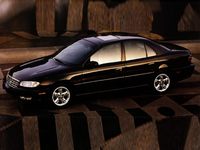1995 Cadillac Catera Review
by Ted Laturnus
SEE ALSO:Cadillac Buyer's Guide
Somebody once said that typical Cadillac owners are somewhere between 65 years of age and dead. A cruel description, but, until recently, fairly accurate. Certainly, the General Motors luxury car division has done little to change that image, bringing out a mind-numbing succession of over-sized, luxury-laden parade floats like the Deville, Fleetwood, Eldorado and so on even when no one was buying them and their traditional customer base was six feet under. These kinds of cars were aimed directly at geriatric retirees whose idea of class was a car with a vinyl roof, loud paint, and as much glitz as they could hang on it. To hell with handling and performance, give me chrome!
I once made a point of counting all the badges on a Cadillac Fleetwood a couple of years ago. You know…..the corporate logo of a shield and crown surrounded by a garland of wheat? I came up with no less than 28 separate badges, emblems, imprints, insignias and name-tags. They were on the hubcaps, on the trunk and hood, on the floormats, on the dashboard, on the steering wheel, the doors, the seats, even the seat belt buckles. Twenty-eight badges to remind you just what it was you were driving. Until a few years ago, this was Cadillac’s idea of engineering.
Then they brought out the Seville STS, in the early 1990s. Wow. A car that actually felt like it should be somewhere other than in a funeral procession or wedding party. Still wallowed through the corners, had the braking prowess of an eighteen-wheeler, and featured far too much chrome and glitter, but it was a start.
Now with the introduction of the Catera, Cadillac seems to have found its stride. Abandon any notions you may have of Cadillacs of yesteryear. The Catera is a lively, nimble sports sedan that can hold its own with anything else in this class. Well, almost.
Introduced to the press in early 1994 and put on the market in the Fall of last year, the Catera is essentially the German-built Opel Omega, slightly North Americanized. But not too much. Different grille, paint schemes, trim, wheels, and interior appointments, but essentially the same car. Power is provided by a 3.0 litre V6 engine with twin overhead camshafts, four valves per cylinder, and sequential fuel injection. It develops 200 hp at 6000 rpm, and is mated to a four-speed automatic transmission only. But here’s the best part: it’s rear-wheel-drive! For those of us who still view front-drive with suspicion, this is a bonus. It also gives the Catera predictable handling and a nice tight turning radius. It is not an asphalt-gobbling road warrior like the BMW 328i or Audi A8, for example - Cadillac hasn’t changed its stripes that much - but the Catera offers above-average handling, and is actually pretty good around town. The V6 is a tad on the chatty side and not especially smooth, but it’ll take the 1710 kilogram (3770 lb.) Catera from a dead stop to freeway speed in about 10 seconds. Fuel economy is decent, but not outstanding: 12.9 L/100 km (22 mpg) in the city, 8.7 L/100 km (33 mpg) on the highway.
Unsurprisingly, the Catera is chock-a-block with luxury accoutrements….it is a Caddie, after all. Standard equipment includes air conditioning, cruise control, power door locks and windows with a 10-minute power reserve after the car is shut off, leather interior, heated seats front and back, heated outside mirrors, front and rear reading lamps, and on and on. Safety equipment includes dual front air bags, ABS, anti-theft system, childproof rear door locks, and a traction control system. This last feature can be manually de-activated. Everything you’d expect in a luxury car, in other words, and all for a base price of $42,200. By way of comparison, this amount of money will get you a Lexus ES300, Acura 3.2TL, Infiniti I30, or Buick Riviera. The Catera outpoints all of these cars in just about every area. It may lack the refinement of the Lexus, for example, but it’s more fun to drive and quicker off the line. It easily out-handles the Riviera, and is bigger inside than either the Infiniti or Acura.
I think what appeals to me the most about the Catera is its abundance of interior elbow room. I find most of the competitors mentioned a little shy on interior dimensions, and a tad cramped behind the wheel. The Catera is quite spacious inside, with 981 mm (38.6 inches) of front head room. It’s also very easy to get in and out of. No, it’s not as roomy as its more opulent stablemates, but so what? I also like the fact that the brain trust at Cadillac has finally gotten the message about today’s market. The Catera is aimed directly at money-conscious upscale buyers who realize that a vulgar display of wealth is not that attractive, and it’s more fun to drive a car with enthusiasm than isolate yourself behind yards of sheet metal and chrome festoonings. A General Motors executive once described his company as an extremely large ship that is very hard to turn. The Catera demonstrates that GM is indeed a little heavy at the helm, but will change direction eventually.
Oh, and in case you’re interested, I counted a mere 13 emblems on the Catera.



